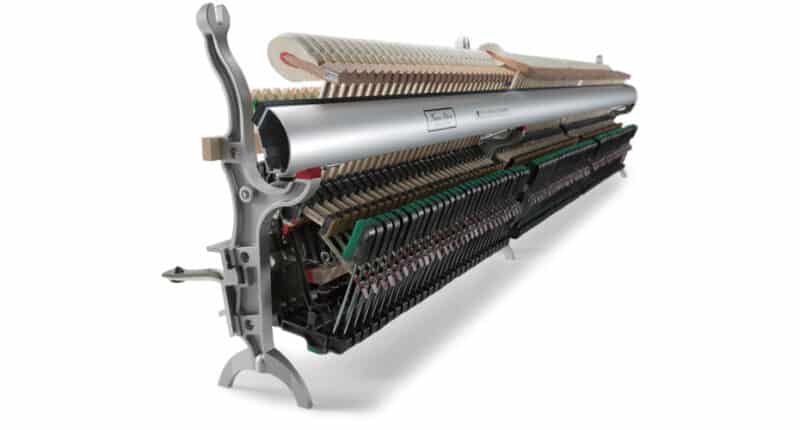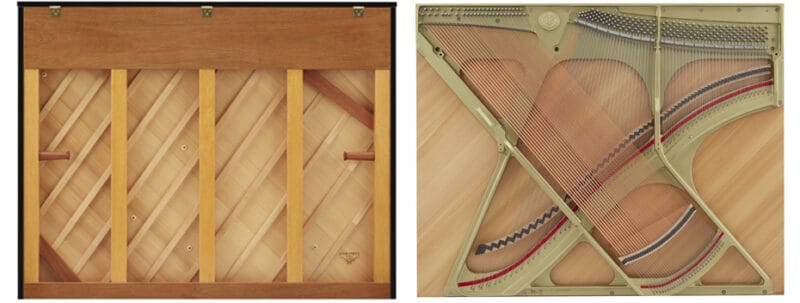Kawai is one of the most dominant players in the acoustic piano world due to their incredible combination of build quality, musical potential, innovation and price.
Kawai’s most popular upright line is by far the K Series Professional Upright Piano series, which is known for its advanced design and material selection throughout the line. The Kawai K-300 is the most well-known and best-selling instrument of the series largely due to its 48” height, with the Kawai K-500 not far behind.
The Kawai K200 Professional Upright piano in turn can be sometimes overlooked in the marketplace while being overshadowed by its bigger siblings, and people are often surprised to hear that the K-200 incorporates almost every feature of the K-300 into a smaller, 45” frame.
If you’re shopping for a new upright of professional quality but don’t want to spring for a European instrument like a Schimmel or a C. Bechstein, you’re definitely going to want to check out this look at the K-200. Be sure to check out the review video for an even more in-depth analysis and some playing examples.
Note that the K-200 is also available in the ATX 3 format, but not as an Aures instrument as of yet.
Kawai K200 – Background

At this point in time, the current version K Series isn’t really new anymore as they first started showing up in North American piano stores in 2013. At the time, the previous generation K Series models like the K-2 and K-3 were upgraded to the K-200 and K-300 respectively, and so on for the entire line.
As we mentioned above, the K-300 has been by far the most popular model of the line, largely due to it being positioned directly against the equally sized Yamaha U1 – one of the most famous upright pianos of all time and the instrument primarily responsible for establishing the 48” upright height marker as the de facto standard size for uprights in North America.
Because the K-200 is smaller at 45”, the value doesn’t scream quite as loudly as something like the K-300, even though the focus on 48” uprights is largely arbitrary, as evidenced by the higher popularity of other upright sizes in Europe.
In many ways then, it’s fair to think of the K-200 as a bit of a hidden gem.
What Models Does the K-200 Compete With?
Given the K-200’s size, impressive specs sheet and relatively meagre price point for a new professional upright piano, it’s a little bit tough to find direct comparable models in the market.
Yamaha’s B Series, particularly the B2, is often cited as a direct competitor to the K-200, but when you compare their respective specs sheets, it’s clear that this isn’t at all an apples-to-apples comparison.
People definitely have their preferences between the Yamaha U1 and the Kawai K-300, and despite a host of technical differences between them, it’s fair to say that they are equal-quality products.
So, there really isn’t a true comparison for the K-200 in the market, and its uniqueness could also be another reason why it is sometimes overlooked.
What Role in the Market does the K-200 Fill?
Now, all of that being said, the K-200 does fill an interesting gap in the marketplace considering what else for around and just below the price point of the K-200.
You’ll find a variety of 48” through 52” options in this range from various Chinese manufacturers, but the K-200 sits above these other options in terms of its build quality, design and materials. If you’re open to a slightly smaller piano, the K-200 is definitely going to provide a superior musical experience with some pretty outstanding tone.
On that note, let’s discuss the sound in more detail.
Piano Sound
Bass Register
We’ll start with the bass register of the K-200, and while this is an area where the size is working against the piano’s potential, Kawai has done a nice job compensating with a great scale design. When you really start hammering these lower octaves, there’s no distortion, woofiness or uncontrolled harmonics like you’ll typically find with shorter uprights.
The length of the string however does genuinely prohibit the fundamental tone from being as prominent as one would like even though the K-200 does feature longer bass strings than normal for a 45” piano, so bass string length is one of the chief advantages of a larger instrument.
When it comes to the dreaded ‘Break’ area (the transition between that three-stringed steel section down into the copper) they’ve actually managed this notoriously problematic area incredibly well. In fact, there are taller pianos available for twice this price that don’t pull off the break as well as Kawai does here.
Tenor Register
Moving into the tenor section, the sound proves to be very nicely blended. The sound is fairly European through middle C, and by that we mean it has a fairly bell-like tone.
This register is also where the sustain of the K-200 really starts to open up, and this is probably Kawai’s crowning achievement with this instrument as the sustain is truly impressive for a 45” piano.
Treble Register
Up through the treble range, we’re now working with a beautifully complex tone. There’s a lovely and harmonious balance between the overtones here, along with a nice balance of cabinet resonance.
Again, this is quite a notable treble complexity for a piano available at this price point.
Piano Action

Millennium III Upright Action
All Kawai upright pianos and grand pianos utilize composite materials for the key actions due to certain inherent issues with wood-based actions. Of course. many high-end European pianos feature high-quality wooden actions, but at the price point the K series uprights are offered, composite actions are going to offer better consistency and durability than a wood action in a similarly priced piano.
The K-200 uses the exact same exclusive Millennium III upright action with ABS-Carbon composites as the K-300 and the rest of the K series line, which is without question one of the hallmark features of this piano.
The biggest advantage of using Carbon Fiber for a piano action is that it results in very low-maintenance as the smaller components don’t react to changes in temperature and humidity the way smaller wooden components do.
From a musical standpoint, certain potential benefits of the Millennium III action include increased repetition speed, and there’s no doubt that this is a very fast action. You can also find this action in the Kawai NOVUS series digital hybrid upright pianos, arguably the most advanced digital pianos currently in production.
Extended Length Key Sticks
Another great feature of this action is the extended key stick length. Having a longer key stick extends the potential force that you can apply to the key because you’re working with a longer lever.
This results in a great level of control for the player, especially at the dynamic extremes. It also makes the action as a whole feel closer to that of a small grand, and this can be quite useful for players who take lessons on a grand piano or are doing a lot of performances or competitions on a grand.
Hammers
The K-200 features underfelted mahogany core hammer moldings, which is quite remarkable as double-felted hammer felts are not common for the price range.
Most hammers on pianos in this class will feature single-felted, maple hammers. Maple isn’t a bad material, but mahogany is lighter and denser and is thus a fixture of higher-end pianos, serving as an upgrade over maple.
Other Notable Features

Soundboard
Another thing that makes the K-200 stand out amongst its peers is the presence of a tapered solid spruce soundboard. A tapered soundboard is expected in higher price points, but is quite rare in this class as the process of tapering a soundboard is quite time-consuming.
The result however is a soundboard capable of producing a more resonant sound, and when combined with the solid spruce back posts the K-200 is outfitted with, we have a big reason why the K-200 is able to punch above its weight sound-wise.
Cabinet & Finishes
The K-200 is most commonly available in Ebony Polish, though it is available by special order in Ebony Satin, Mahogany Polish and Mahogany Satin.
Features of the cabinet include soft fall fallboards, steel reinforced keyslip & keybed, and the aforementioned large, spruce backposts.
All K-200’s come with the standard 3 pedals, brass casters for good mobility, and a height-adjustable bench.
Closing Thoughts
Despite being overshadowed by the K-300, the Kawai K200 is an impressive instrument that really comes together in the top half of the range. The bottom half is well done, but it’s more functional than a major standout, other than the ‘Break’ which is highlight worthy.
The action is excellent and we would go as far as to say that it’s probably the best upright piano action available in a new piano at this price point.
For people who are in the market thinking about a used piano in the 48-inch range, we would urge you not to skip over the K-200. Try this out in a showroom, and if you get pushback from a piano teacher that the piano you choose has to be 48”, we’d urge you to do a little bit more research into this to find out that this piece of advice isn’t really based on anything solid in many cases.
Thanks for reading!


